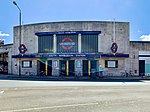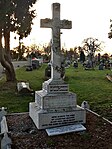Shree Ghanapathy Temple, Wimbledon

Shree Ghanapathy Temple, Wimbledon, is a Hindu temple in south-west London, England, that was established in the 1980s. The main deity in the temple is of Lord Ganesha. There are also deities of Goddess Durga (Parvati), Lord Hanuman, Krishna etc. The Sai Mandir was opened in 1981 and is a prayer hall dedicated to Bhagavan Sri Sathya Sai Baba. It was the first fully consecrated Hindu temple in Europe (1981).During the temple's early years, the realisation came that there was an urgent need to educate the younger generation about Hinduism. Furthermore, the temple wanted the children to fully understand the faith at a deeper level than previously. Therefore, the Sai Mandir has been running classes for many years, teaching the children spiritual education, Sanskrit prayers, how to sing Bhajans (devotional hymns) in addition to learning about other religions too. Voluntary activities take place in affiliation with local authorities and Age Link groups. The temple provides classes dwelling on teachings of Hinduism, music and dance classes, and yoga to name a few.
Excerpt from the Wikipedia article Shree Ghanapathy Temple, Wimbledon (License: CC BY-SA 3.0, Authors, Images).Shree Ghanapathy Temple, Wimbledon
Effra Road, London South Wimbledon (London Borough of Merton)
Geographical coordinates (GPS) Address External links Nearby Places Show on map
Geographical coordinates (GPS)
| Latitude | Longitude |
|---|---|
| N 51.423333333333 ° | E -0.18916666666667 ° |
Address
Shree Ghanapathy Temple
Effra Road 125-133
SW19 8PU London, South Wimbledon (London Borough of Merton)
England, United Kingdom
Open on Google Maps










